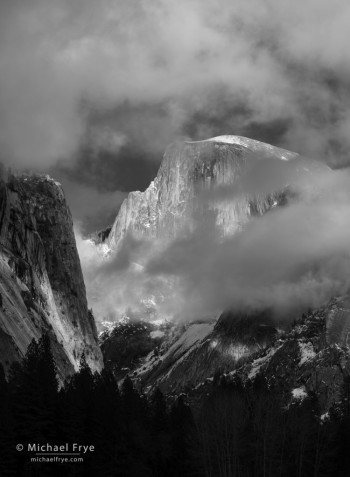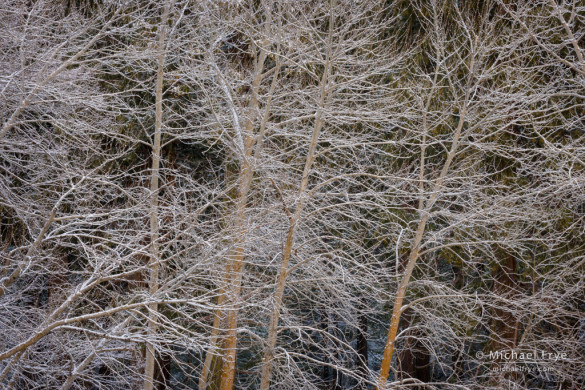Many people, including me, had high hopes for the snowstorm that came through Yosemite on Tuesday. The forecast called for six to twelve inches of snow, so it sounded like we would see some beautiful snow scenes, and maybe even get to photograph a clearing storm. And some moisture might help revive Horsetail Fall.
Around sunset on Tuesday it started snowing at my house in Mariposa — first lightly, then heavily. In no time we had three or four inches of snow, and eventually got six inches, which is a lot for our 2700-foot elevation.
But the storm looked very compact on radar, and the precipitation didn’t seem to be reaching Yosemite. I called my friend Kirk Keeler, who lives in Yosemite Valley, and he told me that they had received only half an inch of snow.
Wednesday morning Claudia and I cleared the snow off our car and drove up to Yosemite Valley. We found an inch or two of snow — not a lot, but enough to highlight every tree branch. I saw many beautiful scenes with trees etched in snow, including the pattern of cottonwood branches below.
The morning was clear, but later some evaporation clouds started to appear, and they kept building. By the end of the day all the cliffs were hidden by clouds. But between 4:00 to 4:30 in the afternoon Half Dome and the clouds put on a great show. Half Dome would vanish completely, then reappear, wrapped in clouds and speckled with sunlight. I made the photograph above just before Half Dome disappeared for good.
Unfortunately the dusting of snow did little to improve the water level in Horsetail Fall. And our dry weather pattern is expected to continue. There’s a slight chance of showers tonight, but then no precipitation in the forecast for the coming week. Let’s hope that we get some good storms in March to give us booming waterfalls in April and May!
Wednesday also happened to be Ansel Adams’ 111th birthday. After dark we attended a program commemorating the event presented by Ansel Adams Gallery staff members Evan Russel, Mike Reeves, and the aforementioned Kirk Keeler. They did a great job, mixing history with beautiful photography — their own as well as Ansel’s.
There’s another event tonight: the reception for the 28th annual Yosemite Renaissance exhibit (5:30 to 7:30 p.m. at the Yosemite Museum, next to the Visitor Center). If you’re in Yosemite this is a great chance to see some beautiful artwork, and meet lots of interesting people. Maybe I’ll see you there.
— Michael Frye
Related Posts: A Quick Horsetail Fall Update; Latest Horsetail Conditions
Michael Frye is a professional photographer specializing in landscapes and nature. He is the author and photographer of The Photographer’s Guide to Yosemite, Yosemite Meditations, and Digital Landscape Photography: In the Footsteps of Ansel Adams and the Great Masters, plus the eBooks Light & Land: Landscapes in the Digital Darkroom, and Exposure for Outdoor Photography. He has written numerous magazine articles on the art and technique of photography, and his images have been published in over thirty countries around the world. Michael has lived either in or near Yosemite National Park since 1983, currently residing just outside the park in Mariposa, California.











I like the luminous quality of Half Dome in this photo.
Thanks David!
Michael – I’ve just got to tell you, your blogs are a godsend. Living not in Mariposa, but in Napa, it’s a bit more of a trek for me to pop on over to Yosemite. Yet, as a lifelong, large format landscape photographer, I still drop everything and go wherever I can to perhaps capture something out of the ordinary … or, as you so often show us, even the “ordinary” in nature can be breathtaking. This blog post, and the past couple, have been cases in point. Despite a low-flow year for Horsetail (I was probably beside you shooting Horsetail this past Friday!), there was still much to be photographed. With your blogs as inspiration — and information — I had a great several days photographing all over over the Park. I have the deepest respect for your photography, for your writing and for your generosity with your knowledge. Thanks for everything.
Thanks very much Stephen for all the kind words! I’m glad this blog has provided some help to you in your photographic quests — that what it’s all about.
I happened to look at the half dome webcam just about the same time you took this and thought gee that’d make a nice photo. I guess it pays to be on the scene instead of at home!
I was curious why you used f22 in this situation. For slower shutter speed to soften the clouds slightly maybe? I’ve seen the recommendation to avoid stopping down too much unless you’re going for extra depth of field or slower shutter speed or some other specific reason because you tend to lose sharpness stopped down like that. thanks for the great blog.
Nice bit of serendipity RT. To answer your question about f/22, no, it wasn’t to slow the shutter speed. On this lens f/22 is my sharpest aperture. Most lenses are indeed sharper at middle apertures like f/8 and f/11, but this is not universal. For a detailed discussion about all this read my reply to Andrew Chan in the comments of this post:
https://www.michaelfrye.com/2012/12/04/a-familiar-sound-returns-to-yosemite-valley/
Just finished a few days at Yosemite and wanted to let you know your guide book was a wonderful resource especially the directions which turned out to be spot on the mark. It really did make efficient planning. Keep up the good work it really was very helpful.
The only glitch was my surise trip to Tunnel view. Living on the east coast where a 6:30 sunrise means the light floods the area at 6:30 I neglected to account for 10K + foot peaks to the east. Next time I’ll be sure to consult the Ephemeris and sleep in a bit longer.
Thanks Chuck — I’m glad the book was helpful to you. Yes, sunrise usually arrives late in Yosemite Valley, but not always. Sometimes clouds light up well before sunrise to the east.
It was good to see you at the Yosemite Renaissance. I also notice that William Neil shoots quite often at f22. He uses some third party sharpening software – not lightroom. Now please make it snow! Winter is almost over.
It was good to see you too Hugh. I don’t know what Bill does, but there is no sharpening method that is some kind of magic bullet for fixing fuzzy photos. But snow makes any aperture look better!
Michael, love this photograph and the updates about Yosemite; your guide helped so much the last time I scooted over from the Bay Area. Question: have you written somewhere about black and white digital? I am an old school b&w photographer who has how gone digital, but I don’t know best practices…in-camera settings or Lightroom afterwards, as an exame of one question I have. . Inquiring minds want to know! Best, Stacey
Thanks Stacey! I have not written about black-and-white digital photography specifically, but do talk about it quite a bit in my book Digital Landscape Photography. To answer your specific question, you definitely want to capture in color and convert to black and white in software, as this gives you much more control over the black-and-white conversion. If you’re shooting Raw you have no choice, as Raw images are always in color (unless you buy a special black-and-white-only camera).
Hi Michael,
I love how the clouds frame Half Dome.
A fresh coat of snow does wonders! I recently was faced with the quandary of either x-country skiing or photographing. The camera won, as I figured the snow would be falling off the trees as it warmed up, and could go skiing later.
I like your choice Vivienne! Though I like skiing too, and am sometimes faced with the same dilemma. 🙂
Michael, was this shot at Tunnel View?
No, the Half Dome image was made from the Ahwahnee Meadow.